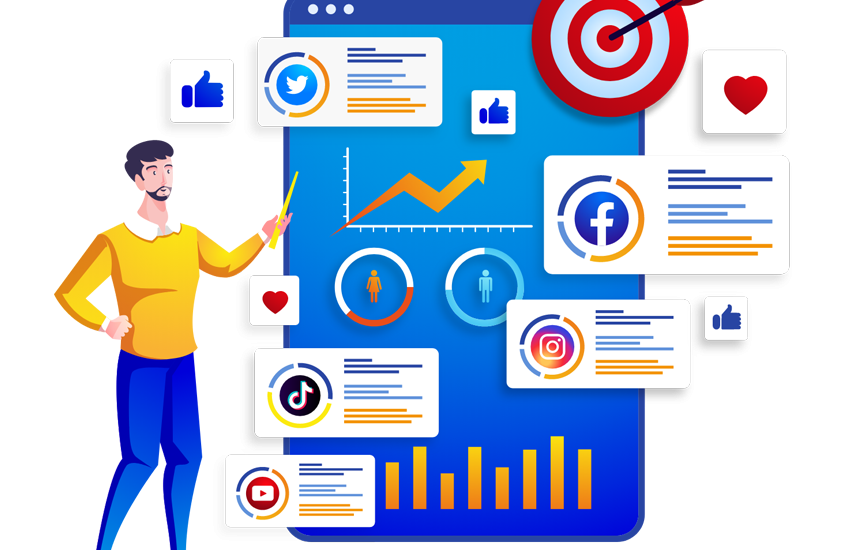Introduction to Strategies for Digital Marketing
In the rapidly evolving business landscape, digital marketing has become a cornerstone for achieving success and maintaining competitiveness. As we look toward 2025, businesses must recognize the critical need for a digital marketing plan that is specifically tailored to their unique requirements. The digital world is constantly changing, with new platforms, tools, and consumer behaviors emerging at a breakneck pace. This necessitates a strategic approach to marketing that can adapt to these shifts and leverage them for business growth.
Crafting a digital marketing plan involves a deep understanding of the myriad channels available for reaching potential customers. From social media and email marketing to search engine optimization (SEO) and content marketing, each channel offers distinct advantages. However, their effectiveness depends on how well they are integrated into a cohesive strategy that aligns with the business’s objectives. It’s not just about being present on these platforms; it’s about engaging with the audience in a way that is meaningful and resonates with them.
Another essential component is data-driven decision-making. The advent of advanced analytics tools allows businesses to gather and interpret data like never before. This data can provide invaluable insights into consumer preferences, behavior patterns, and overall market trends. By harnessing this information, businesses can make informed decisions that enhance their marketing efforts and drive better outcomes. Data helps in refining marketing strategies, identifying new opportunities, and optimizing campaigns for maximum impact.
Personalization is also key in today’s digital marketing landscape. Consumers are no longer satisfied with generic messages; they expect content that speaks directly to their needs and interests. Tailoring marketing efforts to address these expectations can significantly improve engagement and conversion rates. Whether it’s through personalized email campaigns, targeted social media ads, or customized website experiences, businesses that prioritize personalization are more likely to build strong connections with their audience.
In summary, the importance of a well-thought-out digital marketing plan cannot be overstated. With the right strategy, businesses can navigate the complexities of the digital landscape, effectively reach their target audience, and achieve their goals. As we move closer to 2025, staying ahead in the digital marketing game will require continuous innovation, a keen understanding of evolving trends, and a commitment to delivering value to the audience.
Grasping Market Dynamics and Target Audience
To create a successful digital marketing plan, businesses need a thorough understanding of market dynamics and their target audience. This involves identifying key demographics and analyzing their behaviors, preferences, and pain points. Detailed market research provides valuable insights into what resonates with potential customers, enabling companies to craft messages that are both relevant and compelling.
Competitive analysis is another critical component. By examining the strategies and performance of competitors, businesses can identify best practices and areas for differentiation. Understanding what others in the industry are doing well—and where they are falling short—can help businesses carve out their unique position in the market.
Consumer behavior trends are constantly shifting, influenced by various factors such as economic changes, technological advancements, and cultural shifts. Staying updated on these trends helps businesses adapt their marketing strategies to remain relevant. For instance, the growing preference for mobile shopping or the increasing importance of social media influencers can significantly impact how a company engages its audience.
Segmenting the audience into distinct groups based on specific criteria, such as age, location, or purchasing behavior, allows for more targeted and effective marketing efforts. Each segment may have different needs and preferences, and addressing these distinctions can lead to higher engagement and conversion rates. Personalized content and offers can make a significant difference in how a message is received and acted upon.
Additionally, businesses should not overlook the power of psychographics—understanding the values, attitudes, and lifestyles of their target audience. This deeper level of insight can inform not only the messaging but also the overall brand positioning and voice. By aligning marketing efforts with the core values and interests of their audience, businesses can build stronger, more lasting connections.
Technological tools like customer relationship management (CRM) systems and advanced analytics can aid in gathering and analyzing data about the target audience. These tools provide a clearer picture of who the customers are and how best to reach them. Businesses can then tailor their marketing strategies to maximize engagement and ROI.
Understanding the broader market landscape and intricacies of the target audience equips businesses with the knowledge needed to create impactful, tailored marketing strategies that drive results.
Tailoring to Meet Unique Business Objectives
A tailored digital marketing plan should closely reflect the unique goals and priorities of each business. For instance, a startup looking to build brand awareness will need a different strategy than an established company aiming to boost sales in a competitive market. Recognizing these differences is the first step in creating an effective plan.
One size does not fit all when it comes to digital marketing. Businesses need to identify what sets them apart and leverage these unique selling points in their marketing strategies. This could mean highlighting innovative products, exceptional customer service, or unique brand values. By focusing on what makes the business special, companies can create more compelling and engaging marketing campaigns.
Additionally, the industry in which a business operates will greatly influence its marketing needs. A tech company may benefit from showcasing its latest advancements through detailed blog posts and video demonstrations, whereas a retail brand might see more success with visually appealing social media posts and influencer partnerships. Understanding these industry-specific nuances ensures that marketing efforts are both relevant and effective.
Flexibility is another crucial element of a tailored digital marketing plan. Market conditions, consumer preferences, and technological advancements are constantly evolving. Businesses must be prepared to adapt their strategies as needed to stay relevant and competitive. This could involve experimenting with new marketing channels, adjusting messaging to better resonate with current trends, or reallocating budget to the most effective tactics.
Incorporating customer feedback into the marketing plan is also vital. Listening to what customers have to say can provide invaluable insights into what is working and what is not. This feedback loop allows businesses to fine-tune their marketing efforts continuously, ensuring they meet customer expectations and drive desired outcomes.
Collaboration between different departments within a business can further enhance the effectiveness of a digital marketing plan. Marketing teams should work closely with sales, product development, and customer service to ensure a cohesive approach that aligns with overall business objectives. This integrated effort can result in more consistent messaging and a stronger overall strategy.
By focusing on the specific needs and goals of the business, a tailored digital marketing plan can drive more meaningful and measurable results.
Harnessing Technology and Innovative Tools
In the digital marketing arena, the strategic use of technology and innovative tools can significantly elevate a business’s efforts. One of the primary ways businesses can leverage technology is through data analytics. By analyzing vast amounts of data, companies can gain actionable insights into customer behavior, campaign performance, and market trends. This enables them to make informed decisions that drive their marketing strategies forward.
AI and machine learning have become game-changers in personalizing customer experiences. These technologies can predict customer preferences and behaviors, allowing businesses to tailor their marketing messages with pinpoint accuracy. AI-driven chatbots, for instance, can provide instant customer support, gather data on customer inquiries, and enhance the user experience on websites.
Automation tools are another crucial component in streamlining marketing processes. Marketing automation platforms can manage email campaigns, social media posts, and ad placements, reducing manual effort and ensuring consistency across all channels. This not only saves time but also allows for more precise targeting and segmentation.
Customer relationship management (CRM) systems are indispensable for maintaining and organizing customer data. They help businesses track interactions, manage leads, and foster long-term relationships with their audience. By integrating CRM with marketing automation, businesses can create highly personalized campaigns that resonate more deeply with their customers.
Emerging technologies like augmented reality (AR) and virtual reality (VR) offer unique opportunities for creating immersive marketing experiences. For example, retail brands can use AR to allow customers to virtually try on products, while VR can provide interactive product demonstrations or virtual tours.
Blockchain technology, while often associated with cryptocurrencies, is finding its place in digital marketing as well. It offers enhanced security and transparency for digital transactions, helping to build trust with customers. Additionally, blockchain can improve data privacy and prevent ad fraud, making digital advertising more reliable.
Voice search optimization is another area gaining traction as more consumers use smart speakers and voice assistants. Optimizing content for voice search can help businesses reach a broader audience and stay ahead of this growing trend.
By incorporating these advanced tools and technologies, businesses can create more efficient, effective, and innovative digital marketing strategies that cater to the evolving needs of their audience.
Evaluating Success and Making Adjustments
Assessing the effectiveness of a digital marketing plan is an ongoing process that demands regular attention. To gauge the success of marketing initiatives, businesses should establish clear key performance indicators (KPIs) that align with their objectives. These KPIs could include metrics such as website traffic, conversion rates, customer engagement, or return on investment (ROI). By consistently monitoring these indicators, companies can gain valuable insights into what is working and what needs improvement.
Regular data analysis plays a critical role in this evaluation process. Using analytics tools, businesses can track the performance of individual campaigns and overall strategy. This detailed examination can uncover patterns and trends that may not be immediately apparent, allowing for more informed decision-making. For instance, if a particular social media platform is driving significant traffic but low conversion rates, it might be worth exploring why and making necessary adjustments.
Customer feedback is another essential component in evaluating success. Engaging with customers through surveys, reviews, and direct interactions provides firsthand insight into their experiences and satisfaction levels. This feedback can highlight strengths to build upon and areas that require attention. Additionally, it fosters a sense of connection with the audience, showing that their opinions are valued and acted upon.
Flexibility and adaptability are key to maintaining an effective digital marketing plan. The digital landscape is ever-changing, with new technologies, platforms, and consumer behaviors emerging regularly. Businesses should be prepared to pivot their strategies in response to these changes. This might involve experimenting with different types of content, adjusting targeting parameters, or reallocating resources to more effective channels.
Collaboration across departments can further enhance the evaluation process. Marketing teams should work closely with sales, customer service, and other relevant departments to gather a comprehensive view of performance. This collaborative approach ensures that all aspects of the business are considered when making adjustments, leading to a more cohesive and effective strategy.
Establishing a Robust Online Footprint
Creating a strong online presence is essential for businesses looking to thrive in today’s digital age. An effective content strategy is at the heart of building this presence. Businesses should focus on producing high-quality, relevant content that engages their audience and provides value. This can include blog posts, videos, infographics, and social media updates that resonate with the target audience.
Leveraging social media platforms is another critical aspect. Each platform offers unique advantages and can help businesses reach different segments of their audience. By maintaining active profiles and regularly sharing engaging content, businesses can foster community and build brand loyalty.
SEO is also crucial for enhancing online visibility. Optimizing website content for search engines helps attract organic traffic, making it easier for potential customers to find the business online. This involves using relevant keywords, creating informative meta descriptions, and ensuring the website is mobile-friendly and fast-loading.
Email marketing should not be overlooked either. It remains one of the most effective channels for nurturing leads and maintaining customer relationships. By sending personalized and valuable content directly to the inboxes of subscribers, businesses can keep their audience informed and engaged.
Interactive content, such as polls, quizzes, and live videos, can further boost engagement. These formats encourage audience participation and can provide valuable insights into customer preferences and behavior.
Additionally, businesses should consider maintaining a consistent brand voice and aesthetic across all online platforms. Consistency helps reinforce brand identity and makes the business more recognizable.
By integrating these strategies, businesses can establish a comprehensive and robust online footprint, ultimately driving long-term growth and success in the digital landscape.






